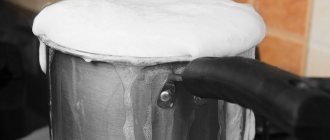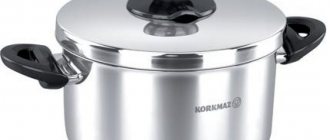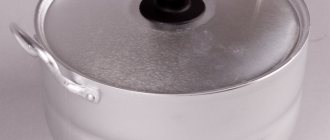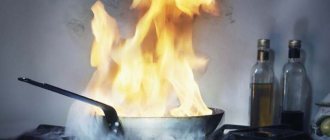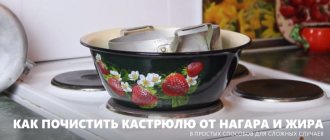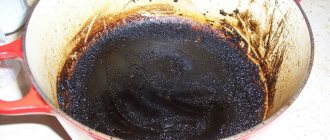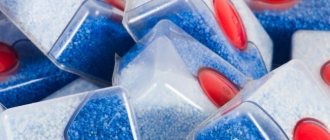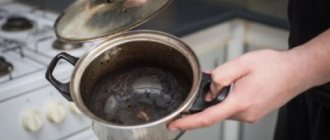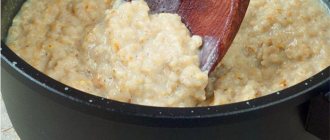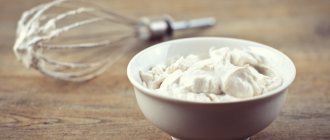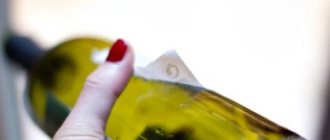Many housewives are faced with a situation where the shiny surface of a pot or frying pan becomes covered with dark soot, which cannot be cleaned off with regular dishwashing detergent. If the slightest manifestation of such contamination is detected, it is necessary to get rid of it immediately. Otherwise, burnt particles may fall off, get into food and negatively affect the human body. How to clean the burnt bottom of a pan? The most important thing is to choose the right effective cleaning agent that will not harm the metal.
How to clean a pan from burnt porridge
Everyone is familiar with situations when a pan, in which there was not enough water or the fire on the surface of the stove turned out to be much larger than required, is tightly connected to the cereal. Although initially it was planned to simply cook tasty and healthy porridge.
You can wash a burnt pan and the contents that have burned on it; you will need to use the following means:
- Clean the pan using this method:
- first remove the burnt contents with a washcloth;
- after the container has cooled, add a liter of water and a tablespoon of salt;
- boil the composition;
- treat the inner walls and bottom with vinegar and soda applied to a dish sponge.
- Enameled dishes require a special approach to solving the problem of how to clean a pan from burnt porridge. The fact is that any scratching compounds can violate the integrity of the enamel and spoil the product. Therefore, the most rational way to clean them is the following option:
- soak the container in cool water;
- Wipe the bottom thoroughly using a soft fiber sponge;
- If the previous steps did not produce results, boil a liter of water and a tablespoon of any detergent in a burnt pan.
- Ceramic dishes can easily be removed from the remains of burnt porridge; you just need to soak them in cool water for a while.
- Pans made of aluminum alloys are more difficult to clean because the burning area can become deformed and take on irregular shapes. It is best to avoid such situations, and if they occur, boil a liter of salt water in a bowl, and then try to carefully clean the carbon deposits with a soft washcloth.
- The ideal material is stainless steel, which is not at all afraid of burnt porridge, because it can be easily wiped off with a sponge of any hardness using a cleaning agent.
Process Features
The correct approach to work will not only allow you to quickly clean kitchen utensils, but will also preserve their durability. Therefore, it is important to use the “right” means and methods. Different metals react differently to cleaning agents. For example, acid damages enamel, and the use of abrasives is contraindicated for all types of non-stick coatings. Each type of material has its own rules of care - both effective and gentle.
There are many powerful agents that can cope with carbon deposits. To make their work easier, some housewives use oven cleaning products and grease solvents. Unicum, Sanita, Schumanit (Bagi), Oven Cleaner (Amway), and Velikan (Bagi) are considered to be products that effectively remove stubborn grease stains. It is worth noting that at the same time they are one of the most poisonous cleaning products, so it is not recommended to use them frequently. Work with them with gloves, with the window open, and most importantly, rinse the dishes thoroughly, eliminating the remnants of the detergent itself.
When choosing a cleaning product, you should consider the material from which the pan is made
How to clean a pan from burnt food at home
Salt is the first assistant in the fight against pollution.
Most often, women use store-bought formulas for washing dishes, but home remedies can help solve the problem of how to clean a burnt pan just as effectively.
- Salt is almost always used; it must be mixed with water, and then thoroughly boil the resulting composition. If you don’t want to boil it, you can simply keep the solution in the container for 3 hours, then thoroughly wash the container using a washcloth.
- Activated carbon will do a great job of removing burnt food in pots made from different materials. You need to use it like this:
- Grind 4-5 tablets to a powder;
- Apply this composition generously to the soiled elements of the dishes and leave for up to one hour;
- then add cold water and leave the container for half an hour;
- After that, wash off the carbon deposits with any detergent.
- Citric acid or ordinary vinegar will quickly and easily remove traces of plaque from the pan and help wash away burnt sugar. You need to use these tools like this:
- pour the liquid onto the burnt surface and leave it like that for 2–3 hours;
- Now you can wash off the remaining carbon deposits with a sponge.
- You can remove traces of rice that has stuck to the dishes by pouring whey into it and leaving it for a day. The acids contained in this drink dissolve plaque quite well and make it easy to clean even without the use of abrasives.
- Pots made of different materials can be washed using liquid soap, which must be poured into a container and boiled for half an hour. As a rule, this method works excellent if the burning is not too severe.
- To clean enamel surfaces, you can put sour-tasting apple peels in a container and leave for a while.
Veronica
- The sooner you start saving your favorite dishes, the more effective the result will be. The “damaged” dishes that were left in the far corner may still have yellow spots after cleaning.
- Do not pour cold water into hot enamel cookware; let it cool; a sudden change in temperature may cause the enamel to crack and chip. Fill the slightly cooled pan with water at room temperature.
- Do not wash an enamel pan with a metal brush - you can ruin the dishes.
Simple salt will help clean a burnt enamel pan.
Salt eats away burnt food residues. There are several options. For example, generously sprinkle the burnt bottom with salt and leave the dishes for 2 - 3 hours, then rinse. Another option is to prepare a saturated salt solution: 5 - 6 tablespoons of salt per liter of water. Then you should replace the ordinary water in the burnt pan with salted water, put the pan on the fire and boil for 30 - 40 minutes. Pieces of burnt food should completely move away from the walls and bottom of the pan. The “soda method” is also good. Soak the pan overnight in a thick soda solution, and in the morning boil the solution for 1.5 - 2 hours. If the dishes are not completely clean, fill the pan with fresh soda solution and repeat boiling.
Stainless steel utensils damaged during cooking can be saved in other ways:
- Cleaning with activated carbon. Take 2 tablets of activated carbon (for a medium sized pan), grind it into powder, sprinkle the powder on the burnt areas and pour in a little warm water (you should get the consistency of a thick paste). Let the dishes stand for 20 minutes, after which all dirt will be easy to remove with a simple sponge.
- Remains of burnt food can be removed by boiling. Fill a pan with hot water and add a small amount of liquid soap or dish soap. Place on the fire for 10 - 15 minutes. Once boiled, the pan will be easy to clean.
Aluminum cookware is not uncommon in modern kitchens. It is easiest to clean it from burnt marks, but you should not use metal scourers, aluminum is easily deformed. Boil the pan by adding the onion to the water. The onion can be replaced with a couple of drops of ammonia. The “soda method” can also be used in this case.
Teflon-coated dishes should be soaked and boiled with non-alkaline solutions; under no circumstances should they be cleaned with powders or abrasive detergents.
How to clean a pan from burnt food?
First, you need to understand what kind of coating the cookware has: stainless steel, aluminum, or enamel? Secondly, what exactly burned? Thirdly, you should not put off washing the pan until tomorrow, but take action right away.
How to clean a stainless steel pan?
Pots made of stainless steel have a fragile coating and are sensitive to strong cleaning agents. It is not recommended to wash them with detergents based on chlorine and ammonia, and it is also not advisable to rub the bottom with hard metal brushes.
The most common means for cleaning such pans is baking soda, which probably everyone has in their kitchen. Sprinkle the bottom of the pan with a few tablespoons of baking soda and let it sit for half an hour. Then pour hot water over the burnt bottom of the dish, put it on the stove and boil over low heat for 15 minutes. After this, the bottom can be washed with a regular dishwashing sponge.
There are several other ways and means to clean a stainless steel pan: You can use activated carbon powder. Depending on the volume of the pan, you need to take three or four tablets per 3 liter pan and grind them into powder. Then sprinkle the damaged bottom, pour a glass of hot water and leave for half an hour, after which it will be easier to wash it.
There are situations when food is burnt quite badly. How to clean a badly burnt stainless steel pan? In this situation, ordinary table vinegar will help. Fill the bottom of the pan completely for several hours. Then wash the pan with a regular sponge in warm water.
Cleaning burnt aluminum pans
It’s not uncommon to find aluminum pans in your kitchen utensils arsenal, which can always be polished to a shine and look like new.
Many people, however, have abandoned this type of pan, since they are not always made of high-quality material and are often not healthy if cooked in them.
But we’ll tell you how to wash them.
The easiest way is to pour a packet of citric acid into the bottom of the container and let it sit for a while. Then you need to add warm water, boil for half an hour and wash the pan with a sponge.
You can also boil a soda-soap solution in damaged dishes, consisting of soda and detergent, a teaspoon of each.
Oddly enough, carbonated drinks such as Coca-Cola, Pepsi, Sprite and drinks with similar compositions often dissolve dirt from the surface of the pan and return it perfectly. Therefore, fill the pan with sparkling water and leave it overnight. In the morning the result will surprise you.
How to clean an enamel pan from burnt food?
This coating requires caution. The enamel surface is sensitive to sudden temperature changes and to cleaning agents, even sponges. Make sure that cleaning is carried out exclusively with warm water. Pour salt onto the bottom, add half a liter of water and boil for up to an hour. It is much easier for scale to leave the bottom.
Everyone knows that it is very difficult to wash a pan after making jam. Citric acid and hot water can cope with this task. One pack citric acid, pour 500 ml of water and boil for 30 minutes, then wash with a sponge in warm water.
How to wash burnt milk from the bottom of an enamel pan?
You will need a small amount of coffee grounds, which will provide a scrub effect. Rub the bottom thoroughly and leave to sit for several hours. Afterwards, lightly wash off any remaining burnt milk with a sponge. To wash an easily burnt enamel pan, you need to fill it with yogurt overnight. In the morning you can boil it a little and rinse with water at room temperature.
How to clean a pan from burnt porridge (buckwheat, rice, millet, etc.) Everything here is very simple for any type of pan. A saline solution will help: 1 spoon of salt and 1 liter of water, boil for about an hour and wash off the dirt with warm water.
What to do if an enamel pan is burnt?
The most effective cleaning of carbon deposits occurs when the plaque is still fresh. To do this, it is important to immediately place the dish in hot water and fill it.
The following cleaning steps:
- add dishwashing detergent to the water;
- the filled pan must be left for several hours;
- Try washing with the hard side of a dishwashing sponge.
It is important to remember that enamel is a fragile coating, so you should not use too harsh abrasive detergents.
Methods for cleaning a pan from carbon deposits
It is extremely important to get rid of old carbon deposits in a timely manner, since soot and the old oil from which it consists, when heated, release carcinogenic substances that slowly poison a person. Common methods for cleaning enamel-coated pans can be either chemical or folk.
Folk remedies
To remove a layer of soot from an enamel pan, the following folk remedies are used:
- Coarse table salt - you need to pour 250 grams of salt on the bottom, add water and put it on a hot stove to boil. After 20 minutes of boiling, you need to pour out the water and clean the carbon deposits with a dishwashing sponge and detergent.
- Sand – used to clean dishes both inside and outside. To clean, sand is poured onto a sponge or rag and rubbed over the walls of the pan with soot. This type of cleaning is suitable for heavy soiling.
- Citric acid - several sachets of the product must be poured into a container and boiled for several minutes. The product is excellent for removing not only soot and dark deposits, but also scale.
- Baking soda can be used both as an abrasive for mechanical cleaning and as an active substance. To do this, you need to pour a few tablespoons of powder into an enamel pan, pour boiling water over it and leave overnight. In the morning, the plaque will be cleared off much easier. If you did not use an enamel pan, but, for example, a stainless steel pan, you can find out how to clean a stainless steel pan here.
- Cleaning pans from burnt milk is effective using bleach or another chlorine-containing bleach. Despite the unpleasant smell, it can not only remove old carbon deposits, but also restore the snow-white color of the coating.
- Lemon juice acts similar to citric acid. It is necessary to thoroughly rub the walls of the container with a slice of juicy lemon and leave for a while, then rinse with dishwashing detergent
- Coffee grounds are used as a soft abrasive of natural origin, which is almost always on hand. Cleaning burnt porridge from a pan using ground coffee is an effective remedy. To use, apply a small amount of coffee to a dishwashing sponge and rub the dirty areas well.
- Acetic acid or a 9% solution is poured into the container to the full height of the contamination and left for 30 minutes. The liquid is then drained and the pan is cleaned in the traditional way.
- Laundry soap must be grated on a fine grater, pour a handful of the resulting crumbs into a bowl, pour boiling water over it and leave overnight. It will be much easier to clean the container in the morning.
- Activated carbon is used if jam is burnt in an enamel pan. The pack of tablets must be crushed and poured into a saucepan, then boiled for 15 minutes. The product is a good absorbent that actively cleanses not only the stomach, but also the walls of the dishes.
- Mustard powder can be used as an effective cleanser. Applied to the rough side of a washing sponge, it is able to quickly clean dishes with dirt of any complexity.
- Onions cut into slices are immersed in water and boiled in a container for 30 minutes. This method can clean not only carbon deposits, but also dark deposits that form during use.
- Soda ash is poured at the rate of 50 g per 2 liters of water and heated to a boil, then you need to leave the liquid until it cools and drain. After which the carbon deposits are cleaned with a sponge and do-it-yourself dishwashing liquid.
By the way, read this article too: How to wash woolen items: by hand and in a washing machine
Folk remedies can be combined to achieve a better effect.
Chemicals
Chemicals are used in cases where there is no time to wait. They are strong and some of them cannot be used without protective gloves. The most common means are:
- Schumanite is an aggressive powder product. It is able to quickly clean even the most stubborn dirt both inside and outside.
- Chister is one of the most budget-friendly options, but in order to clean a thick layer of carbon deposits you need to put in more physical effort than when cleaning with Schumanite.
- Amway produces not only decorative and skincare cosmetics, but also detergents, which are famous for their effectiveness and mild effect. Carbon cleaners are suitable even for new pans.
A pan with a thick layer of old carbon requires more thorough cleaning and most folk remedies are not able to clean it. To do this, you need to combine them or use professional cleaning products.
The most used ones are:
- vinegar 9% + salt + water , the resulting mixture must be brought to a boil in a contaminated container and allowed to cool. Then clean using the rough side of a dishwashing sponge;
- washing powder + sunflower oil until creamy and bring to a boil. Then wash;
- ammonia + borax is applied to a dirty surface and left for several hours;
- carbonated drinks , particularly Coca-Cola, can clean off old carbon deposits. To do this, pour the liquid into a container and simmer over low heat for 20 minutes.
To clean old dishes that have already lost their attractive appearance, you can use metal brushes and sponges, which clean quite roughly, but effectively.
In order not to damage the coating, you must adhere to the following rules:
- new enamel cookware should not be cleaned using too hard metal brushes and sponges; this method is applicable for old pans;
- products containing aggressive acid should be used according to the instructions; prolonged contact of the acid with the enamel can significantly damage it;
- when bleaching and cleaning with bleach or bleach, it is necessary to dilute it with water, since in its pure form it acts like an acid;
- cleaning the pan from carbon deposits inside and outside should only be done with gloves to avoid damaging the skin of the hands;
- the enamel can crack due to temperature changes, so you need to first fill the product and only then heat the container;
- Do not use cleaning products for sinks and toilets, since the acid they contain is harmful to the body if the dishes are poorly washed.
If you have a samovar in your home and use it from time to time, then it also needs cleaning. You can find out how to clean a samovar here.
To maintain the cleanliness of an enamel-coated pan, you sometimes have to use strong products that require the following precautions:
- when in contact with acids, it is necessary to use rubber gloves to avoid liquid getting on the skin, as it can cause redness, soreness and even burns;
- Bulk cleaning products must be poured carefully so that a cloud of dust does not appear;
- It is advisable to use a mask or respirator to avoid inhaling harmful substances;
- You need to rinse the cleaned dishes especially thoroughly to remove the product so that it does not get into your food.
By following these tips, you can avoid a number of common problems that can arise when coming into contact with chemicals.
Cookware coated with enamel requires special care, which will extend its service life for many years:
- There is no need to cook milk soups in enamel-coated containers, since milk tends to burn quickly, and it is quite difficult to clean the carbon deposits.
- After purchase, before first use, you need to harden the coating in this way - pour water to the top and bring to a boil, then let it cool naturally.
- The coating may deteriorate if a large pan with a wide bottom is placed on a small burner of an electric stove - thus, the bottom heats up unevenly. As a result, cracks in the enamel may appear.
- It is strictly forbidden to fry in a container whose bottom is only partially covered with oil or fat.
- Darkened dishes can be bleached using vinegar or a slice of lemon. You just need to wipe the container.
- Dark deposits after cooking vegetables can be easily cleaned with whey.
- Cleaning the pan from burnt food should be gentle so as not to cause scratches on the coating, which over time can turn into cracks. In such dishes, food burns much more often.
- Enamel does not tolerate sudden changes in temperature and can crack.
- Disposal must be made if the integrity of the enamel is damaged - it can release harmful substances when heated.
- Do not allow the dishes to fall from a great height; in this case, chips will certainly appear on the coating.
- The appearance of rust indicates chips and scratches on the coating; it can be washed, but it is not advisable to cook in such dishes, since during heating, rust can be released into the food.
Tips for enamel pans
Enameled pots require special care. To prevent the enamel from cracking or chipping, you must follow the rules for using enamel pans:
- After purchase, you need to harden the enamel. Pour cold water into the pan and boil for 20 minutes over medium heat. Let cool completely. The enamel will become stronger and will not crack.
- Do not put an empty pan on gas. Enamel cannot withstand high combustion temperatures.
- Do not pour boiling water into a cold pan. A sharp temperature contrast will lead to corrosion and small cracks.
- Do not use abrasives or metal brushes for cleaning.
- Do not cook porridge or roast in an enamel pan. Better cook soups and compotes. When cooking compotes, the enamel inside the pan becomes whitened.
By the way, read this article too: How to clean the floor from mercury
Burnt enamel pan
There are several ways to get it in order.
- Moisten the burnt part, pour a pack of activated carbon on the bottom of the pan and leave for 1-2 hours. Fill with water and boil for 20 minutes. Drain the water and wipe with a dry cloth.
- Pour the white into the pan until it burns. Add water to the edges of the pan and leave for 2 hours. Take a large container that will fit your pan, fill it with water and add bleach. Boil for 20 minutes. The dirt will come off on its own. For 8 l. 100 ml of white water is needed.
- Moisten the burnt water and fill it with vinegar 1-2 cm from the bottom. Leave it overnight. In the morning you will be surprised how easily all the fumes will fall away.
Tips for stainless steel pans
This material does not like salt, although it can withstand cleaning with acid and soda. The use of abrasive cleaners and wire brushes is not recommended.
Cleaning stainless steel with products containing chlorine and ammonia will not please you with the results.
Burnt stainless steel pan
- Spread the burnt part of the pan with Faberlic oven cleaner and leave for half an hour. Rinse the pan with water and wipe with a soft sponge.
- Soda ash, apple and laundry soap will help with soot. Soda ash is intended for the care of porcelain, enamel, stainless dishes, as well as sinks, tiles and bathtubs. The product can soften water during washing and soak cotton and linen fabrics.
To prepare the cleaning solution, take 2 tsp. soda for 1 liter. water, add an apple grated on a coarse grater and 1/2 of the laundry soap grated on a fine grater. Dissolve in warm water and bring to a boil. When the solution has boiled, lower the burnt pan into the container and leave on low heat for 1.5 hours. The dirt comes off on its own, and wipe away small stains with a soft sponge.
- “Non-contact cleaning gel” can remove burnt dishes. Apply a little gel to the burnt surface for half an hour and rinse with warm water.
- A good product for cleaning stainless steel pans is Mister Cleaner. Despite its low cost, it copes with burnt marks no worse than the expensive Schumanite.
"Mr. Muscle" and "Silit Beng" showed poor results when cleaning pans without touching them.
Tips for aluminum pans
For proper operation of aluminum pans, you need to calcine them immediately after purchase. To do this, wash the pan in warm water and soap, wipe dry and pour a little sunflower oil and 1 tbsp on the bottom. salt. Heat until it smells specific. Then wash and dry the product. The procedure will create a protective oxide film on the surface of the pan, which will prevent the release of harmful substances into food during cooking or storing food. To avoid damaging the film, do not clean aluminum cookware with soda or abrasive chemicals.
How to clean a saucepan from jam
To clean the pan from burnt jam, use caustic soda. Pour it into the bottom of the pan, add a little water and leave for several hours. Rinse as usual.
You can clean the pan in another way: pour a little water on the bottom and add citric acid. Bring to a boil and add soda. When the reaction passes, add a little soda and boil for 2 minutes. Remove burnt marks with a wooden spatula and rinse with warm water.
How to clear porridge
If your porridge is burnt, baking soda and office glue will help clean the pan. Add 1 tbsp to the water. baking soda and 0.5 tbsp. office glue. Stir and place on low heat. Boil for a few minutes. The boiling time depends on the degree of contamination of the pan. Drain the water and rinse the product.
How to clear milk
If you boil milk in an enamel pan, it will probably burn. After draining the boiled milk into a glass jar, add 1 tbsp to the bottom of the pan. soda, 1 tbsp. kitchen salt and vinegar to cover any burnt areas. Close the lid and leave for 3 hours. Add some water and boil for 20 minutes over medium heat. Leave it for a day. Boil for 15 minutes. The scale comes off on its own. Rinse with clean water.
If the milk is burnt in a stainless steel pan, pour liquid citric acid onto the bottom, bring to a boil and leave to cool completely. Rinse after 1.5 hours.
Cleaning with soap
Suitable for: aluminum, enamel, stainless steel.
Recipe: A burnt enamel pan can be easily washed with soap or liquid dishwashing solution. To do this, fill it with hot water, pour soap shavings or liquid soap into it and place the pan on the stove over low heat. Boil for 20 minutes. After this time, drain the water and wash off the carbon deposits with a sponge, which will soften significantly after the procedure. Use a scraper if necessary.
It is worth considering that this method is not suitable if the pan is very burnt.
Cleaning with salt
Depending on the material from which the product is made, cleaning with salt differs in the recipe:
- A stainless steel pan can be washed like this: fill the container with cold water and leave for a couple of hours. After this time, pour out the water and add a handful of table salt to the bottom of the pan. You should not add it directly to the water, as this may leave dark spots on the metal. By the way, this method is also suitable for an aluminum pan;
- To clean a burnt enamel pan, do not fill it with water: exposure to cold liquid may destroy the container. It is enough to fill the bottom with salt and leave for 2-3 hours, after which the carbon deposits can be easily washed off with a sponge and hot water. If the contamination is too strong, the procedure will have to be repeated.
Cleaning with vinegar
Suitable for: aluminum and stainless steel.
Recipe: You can clean a pan from burnt food at home using 9 percent vinegar, which can be found in any grocery store. If you don’t have the product on hand, you can replace it with citric acid or freshly squeezed lemon juice. If you have a question: “The pan is burnt, how to clean it?”, generously pour vinegar or its substitute over the traces of soot, cover the container with a lid and leave it for two to three hours. Then wash the pan as usual, with a sponge and detergent.
This cleaning method is especially good for aluminum products, since in addition to contamination, it cleans the metal of stains that appear on it over time. Vinegar should not be used to clean enamel cookware.
Cleaning with soda
Suitable for: enamel pans and stainless steel products
Recipe: If you can’t wash off the carbon deposits in a pan using the above methods, then pay attention to soda - a product that every housewife probably has in her arsenal. It can remove internal contamination in a container by simply pouring a handful of baking soda into the bottom of the pan and waiting 30-40 minutes. After this, it will be much easier to clean the burnt pan.
If the vessel is burnt not only inside, but also outside, then soda is an indispensable tool at hand. The procedure for cleaning all surfaces of the pan with soda involves the following steps:
- Remove all plastic and easily meltable parts from the pan;
- Place the product in a spacious tank;
- Pour it with a solution of soda, which is prepared in this way: for five liters of water there is half a kilogram of soda powder. The water should completely cover the pan;
- Bring the water to a boil, then reduce the heat and boil the pan for another couple of hours;
- After this time, turn off the heat and let the water cool;
- Remove the pan from the water and clean the burnt pan in the usual way.
Pan before and after cleaning with soda
Activated carbon cleaning
Suitable for: all types of pans (enamel, aluminum, stainless steel)
Recipe: An effective way to clean a pan if jam or milk is burnt. To begin, take 3 tablets of activated carbon and grind them to a powder. This can be done with a regular teaspoon or use a small sieve.
Grinding activated carbon tablets through a sieve
By the way, read this article too: How to wash white sneakers
Sprinkle the resulting mixture over the soot formed on the pan and leave for half an hour. Next, you should pour cold water into the pan, wait another 30-40 minutes, after which the pan can be easily washed off from dirt.
Cleansing with whey
Suitable for: all types of pans (enamel, aluminum, stainless steel)
Recipe: Whey is a universal product for removing dirt inside a pan, as it is suitable for any material. It contains a large amount of acids and chemical alkalis, which eliminate carbon deposits in an instant.
If a pan made of stainless steel or other steel material is burnt, fill the burnt area with whey 1-2 centimeters above the level of contamination and leave it for a day. After this manipulation, the stain will easily come off even if you wash the pan with a regular sponge and dishwashing solution.
Cleaning with soda-salt mixture
Suitable for: enameled and aluminum products.
Recipe: First you need to prepare the mixture. To do this, mix soda and salt in a 1:1 ratio. Pour the resulting mixture over the soot at the bottom of the pan, add a little water there (to thicken the powder). Leave the vessel for a day. After this time, remove the mixture, fill a saucepan with warm water and boil it for 30 minutes over low heat. After this, wash the container as usual.
If you have a question: “The pan is burnt, how to clean it?”, use the above recommendations - and your dishes will sparkle like new again!
Step-by-step instructions for cleaning a pan
The cleaning process depends on the material from which the burnt container is made. Today, manufacturers offer a wide range of products made of stainless steel, aluminum, as well as certain types of pans with enameled or Teflon coating.
Washing enamel dishes
Step-by-step method for cleaning an enamel pan using baking soda
Do not hesitate to remove burnt stains from an enamel pan. If you start cleaning some time after contamination, yellow spots will remain on the dishes even after the procedure.
Also note that you should not pour cold water into a hot pan. As a result of such exposure, cracks will appear from the inside, and the enamel may break off. Start cleaning when the dishes have cooled down a bit.
The following methods will help you achieve the desired result and return the pan to its previous appearance:
- The simplest and most effective is the use of activated carbon. Grind 10 tablets and pour the prepared powder into a bowl. Cover it with a lid and leave for 15 minutes. Then pour water so that it covers all problem areas and wait another 15–20 minutes. After this time, apply dishwashing detergent to the sponge and wipe the burnt areas.
- Pour vinegar or citric acid diluted in water over the damaged areas for 2 hours. Then clean the surface of the pan using a sponge.
- Dilute 1 tablespoon of soda in 200 ml of water. Pour the resulting mixture into the dishes for 1 hour. Then put it on the fire and wait until the soda solution boils. After half an hour, remove the container from the stove. Sprinkle a little salt or soda on a damp sponge and after the pan has cooled, clean the burnt areas.
- Pour some water into the dishes and add 1 tablespoon of liquid detergent. Stir the resulting solution and leave for 2 hours. Then you need to remove the dirt with a sponge. At the end of the procedure, rinse the container thoroughly with clean water.
Important: The enamel surface must not be cleaned with metal brushes.
Video: washing an enamel surface
Stainless steel pans
Stainless steel must be cleaned very delicately
It is necessary to indicate the means that cannot be used, since they can cause irreparable damage to the dishes. These include:
- detergent compositions with abrasives;
- metal jaws;
- cleaning powders.
Citric acid and soda will help get rid of burnt marks on a stainless steel pan. When using them, you should focus on the methods described above.
Wash dishes using salt:
- Apply salt to water-soaked stains and wait 2-3 hours.
- Then use a sponge with detergent, and there will be no trace of dirt left.
Important: In hardware stores you can find compositions specially designed for cleaning metal products, the use of which also gives good results.
Video: stainless surface processing technique
Cleaning an aluminum pan
You can get rid of recently appeared dirt using baking soda and a sponge:
- Moisten the surface of the dish with water and wipe the burnt areas with soda.
- Then rinse the pan.
- In the case of fresh stains, this will be enough.
Important: If the aluminum pan has a polished finish, baking soda cannot be used to clean it.
Baking soda can easily remove fresh stains
Removing carbon deposits after several uses of the cookware will require more effort, but this task is completely solvable. To do this, you need to do the following manipulations:
- Pour water into the container until the level covers the dirt.
- Then add 1 tablespoon of soda and a little crushed laundry soap.
- Place the dishes on the stove and boil the solution for 20 minutes.
- When the container has cooled, wipe it with a sponge.
A solution of grated soap, soda ash and silicate glue can remove stains. The procedure is as follows:
- All components should be added 1 tablespoon to 2-3 liters of water.
- Then boil the composition in a container for 30 minutes, and after cooling, rinse the container with cool water.
Stains can also be treated with a soap solution with the addition of a few drops of ammonia.
Video: practical tips for cleansing
Particularly troublesome is the carbon deposits on the bottom of the dishes. To get rid of it, use citric acid, apple peel, soap solution or soda. The last two remedies are applied according to the previously indicated methods.
Citric acid is used as follows:
- Pour 10 g of product into a container and fill with water.
- Boil for 20 minutes.
- To increase the concentration of the solution and prevent odors from spreading throughout the house, cover the container with a lid. After cooling, wipe the pan with a rag.
Citric acid will give an excellent effect when boiled
An equally effective option is to use apple peelings. But only peels from sour varieties of fruit are suitable for removing stains. The steps are as follows:
- Boil peelings from 3-4 apples in a dirty bowl.
- Then rinse it and wipe it dry.
Important: Potato peels have similar properties, but they will only help get rid of minor stains.
How to remove burnt stains on a Teflon surface
Teflon is easy and quick to clean
Teflon-coated pans compare favorably with cookware made from other materials due to their resistance to burning. They rarely become dirty, but sometimes there is a need to wash such containers. This doesn't require much effort. It is enough to pour a solution of any dishwashing detergent into the pan for 20–30 minutes, and then rinse the container with clean water.
If the pan is hot, you need to wait until it cools down before starting to work. Do not use abrasives or hard brushes, which can damage the coating.
Important: If carbon deposits appear frequently on a Teflon pan, this indicates that the cookware has become unusable and must be replaced.
Features of removing different types of contaminants
Some stains are particularly difficult to remove. These include burnt milk, jam, traces of buckwheat and rice porridge. Detergents may not be effective against them. Then you need to act on the stains in a comprehensive manner:
- Pour water into a container, add citric acid and soda, boil the composition for 30 minutes.
- When the dishes have cooled, wash them with a sponge.
- Then apply cleaning powder to the surface of the pan and wipe again.
Particularly strong stains may not disappear after the first cleansing. In this situation, leave the solution in the bowl overnight and perform the procedure again the next day.
You can get rid of carbon deposits on a pan using improvised means that can be found in any home. But in order to get the desired result and return the dishes to their original appearance, you need to start removing stains immediately. Do not use a contaminated pan for cooking as the deposits will become more permanent and more difficult to remove.
Even more useful tips on our website! Did you like the article? Share with your friends.
How to clean a pan from burnt milk
If the milk is burnt, baking soda will help clean the dishes.
Such a nuisance as milk that has burnt to the bottom of a pan or stove can not only ruin your mood, but also fill your apartment with a pungent odor that is not very easy to get rid of. That is why it is important to begin rescue measures immediately, without waiting for the aromas to spread throughout the home.
You need to wash a pan from burnt milk at home as follows:
- pour water into a container and place it on the stove over low heat for 30–40 minutes;
- add soda and leave the dishes to soak overnight;
- As a rule, in the morning, burnt milk can be easily cleaned from the surface.
Many housewives are happy to save dishes if they are burnt, using Pemolux or other store-bought products.
As a rule, they contain ordinary soda, flavored with some additives that soften burnt milk without any problems. Separately, it is worth noting this method of washing burnt milk:
- drip lemon juice onto the plaque and sprinkle it with soda;
- then wash the dishes with a regular cleaning product;
- This method will help not only remove dirt, but also whiten the enamel, giving it neatness.
Cleaning pots with craft glue
Ordinary glue, which can be found in every desk, can work real miracles with burnt dishes. You can use it as follows:
- prepare a cleaning composition by mixing 10 liters of water, a bottle of liquid glue, a glass of soda ash and a bar of ordinary laundry soap;
- bring this mass to a boil;
- cook the pots in the mixture for at least 15 minutes, but no more than 3 hours;
- then turn off the stove and leave the dishes in the container with glue, allowing them to cool;
- Now you can treat the surface of the pans with a washcloth or sponge, removing all unattractive soot from them.
Separately, it should be noted that it is not recommended to wash Teflon dishes in this way.
Vinegar
Regular vinegar can clean carbon deposits well. The affected areas are generously watered with vinegar and left for a couple of hours. During this time, the vinegar will break down all the dirt, and you can wash everything almost effortlessly. But keep in mind that this method is completely unsuitable for aluminum.
If you can't find vinegar, you can replace it with lemon juice. It is cut and rubbed on the affected areas, and after 3 hours the container is washed. If you can’t wash off the dirt right away, the procedure can be repeated.
How to clean a pan from burnt jam
Fruits and berries that are boiled in sugar syrup often leave a darkish coating on the surface of the dishes, which is why the question of how to clean a pan from burnt jam does not lose its relevance and is especially acute in summer and autumn.
You can get rid of this trouble if you follow these tips:
- remove the product from the burnt container;
- after the dishes have cooled, fill them with water, to which you can add a little soda or dishwashing liquid;
- As a rule, jam that is burnt lags behind after such exposure after 15 minutes;
- if the effect is not visible, you can leave the burnt pan with this mixture overnight, and then try to scrub it off.
Separately, it is necessary to note measures to save dishes made from various materials.
- Aluminum cookware or stainless steel:
- Do not use abrasives or hard sponges;
- Citric acid diluted in water, which needs to be boiled in a container for 15 minutes, will do an excellent job of removing stains;
- soda mixed with silicate glue is boiled for 30 minutes, after which the soot and food residues come off almost by themselves.
- How to clean jam from ceramic dishes? You can try this method:
- sprinkle the bottom of such a pan with salt;
- leave the container for an hour;
- finally, you can pour water with citric acid and soda;
- then wash the pan with cool water.
- Enameled pans can be washed from burnt jam as follows:
- there is no need to fill such dishes with cold water, so as not to cause sugar to stick to the walls;
- you can boil a liter of water and soda (citric acid) in it;
- In addition, vinegar has a good effect on burnt sugar, but it leaves behind a pungent odor.
Teflon burns extremely rarely because it is a structure to which food does not easily stick. However, if such a problem arises, it is best to soak half an apple or lemon in a bowl. Fruits placed in water will release acid, which will dissolve contaminants.
Tips and tricks
To help you wash your kitchen utensils much less often, first of all, do not leave them unattended on the stove. Forgetfulness and absent-mindedness of the housewife leads to unpleasant consequences, which then need to be eliminated. Use a few tips to make cleaning the kitchen easier:
- Wash the pan after each cooking with dishwashing detergent or laundry soap;
- use only clean rags and sponges for washing;
- Before using cleaning powder, first apply it to an inconspicuous area of the metal and wait a little. The environment should not be aggressive towards the material;
- Always clean the pan from the inside and outside.
Aluminum cookware can be easily restored to its original attractive appearance and shine if it is regularly and properly cared for. This pan will serve you for many more years, use it for its intended purpose and wash it promptly.
We also recommend that you learn how to clean a frying pan from carbon deposits inside and out.
How to clean a pan from yellow deposits
You can get rid of yellowness on the pan using coffee grounds.
The yellowish soot that forms on the surface of pots as a result of not washing them too thoroughly can ruin the appearance of the most expensive set of dishes. To prevent this situation, it is advisable to clean the dishes at least once a week using a mild abrasive agent suitable for this type of container.
In addition, the following home remedies work well with yellow plaque:
- cleaning the walls of dishes with coffee grounds;
- a frying pan soaked in vinegar can be easily and quickly cleaned of yellowness;
- the composition “Persol”, boiled in a saucepan, is considered the optimal method of cleansing;
- 1/2 tablespoon of citric acid can quickly remove yellow plaque;
- you can add “Whiteness”, which you use to wash your plumbing fixtures; it also works well with kitchen utensils, although it requires careful rinsing of the dishes.
A housewife who does not want her dishes to become covered with a yellow coating will promptly clean them from household contaminants and dry them thoroughly, putting them away for storage.
How to clean the outside of a pan from grease
In the kitchen, there are often cases when, due to working with dirty, greasy hands, yellowish traces of a rather dense consistency remain on the surface of the dishes, which are not so easy to remove with just a foam sponge.
It is best to use one of the methods described below:
- A mixture of a tablespoon of PVA glue and a third of laundry soap diluted in water works just fine. You need to use it like this:
- grate laundry soap and mix it with the rest of the ingredients;
- Boil the resulting mixture in a saucepan.
- Cleaning the surface of dishes with soda ash gives good results, but you will have to spend a little time and effort, although the result achieved will be worth it. Note! Not all surfaces can be treated this way.
- Salt, which is stirred in water and the dishes are boiled in this solution for an hour, will help clean enamel and aluminum from treacherous deposits on the surface.
- Any dishes, except enamel ones, can be cleaned with citric acid or vinegar. You need to soak the item that requires washing in such a solution, and after an hour it will remove all dirt.
- If the stains are old, remove them with a detergent, of which there are many on the shelves of hardware stores. The following brands work most effectively: “Shumanit”, “Chister” and the “Amway” product line.
How to wash caramel from a pan
Caramel that clings to the surface of pans is nothing more than burnt sugar. Therefore, the methods for getting rid of it are similar to those described in the section on washing pans from burnt jam. Ridding them of this pollution seems to be a very difficult task, but quite solvable.
You can use the following tools:
- the Teflon coating easily separates from the caramel, you just need to fill it with a large amount of water with the addition of a detergent, and then rinse thoroughly;
- An aluminum surface can be washed by using boiling silicate glue in combination with laundry soap and citric acid or soda, and polishing the surface with a few drops of ammonia will also help.
How to clean a pan from burnt rice
Onions will help clean the surface of the pan.
Probably every woman has wondered how to clean a burnt pan from grains of rice stuck to it. This cereal tends to quickly absorb water, so it’s easy not to keep track of it and miss an important moment when the water was still in the pan and suddenly disappeared.
When the need arises to clean a product from burnt rice, scraping off its particles from the surface immediately comes to mind. However, this method cannot be called rational, because it is very easy to damage the coating. To prevent this, you can use the following means:
- boiling ammonia;
- cleaning the surface with onions;
- fill the bottom with vinegar and leave it like that for 2-3 hours;
- boil a few slices or the peel of a sour apple in such a bowl;
- pour the whey into the container and leave it to act for a day; the grains of rice will fall away by themselves;
- Dilute the soap in water and pour it into the container, after 20–30 minutes the carbon deposits will begin to come off.
Special means
Household chemical stores sell many special products that can remove complex stains. They are used if traditional methods are ineffective.
The most popular types:
Cillit Bang: just apply the mixture to the bottom, wait about ten minutes and rinse the pan. There won't even be a trace left of the soot.- Sanita-gel. This product is based on alkali. It is used according to the same principle as Cillit Bang.
- Schumanite is a product that can clean ovens, baking sheets and burnt pans. When using it, you must follow safety precautions and be sure to wear gloves.
The choice of special means should be approached as responsibly as possible. If cleaning is carried out incorrectly, there is a risk of damage to the coating.
Manufacturers indicate on the packaging which kitchen utensils their products are suitable for. For example, Schumanite is prohibited from being used for cleaning aluminum products.
What to do if the pan is very burnt from the inside
Activated carbon tablets are a safe and effective means for cleaning dishes.
There are often cases when the housewife is distracted by something, and the food that was being prepared completely sticks to the coating.
Let's try to figure out how to clean a burnt pan below:
- using a saline solution, which must be poured into a container and left for a while;
- pour acetic acid onto the burnt surface;
- Soda dissolved in water and boiled over medium heat works well. This leads to the fact that carbon deposits are easily wiped off;
- crushed activated carbon tablets will remove milky buildup;
- food will come off easily if you rub the remaining coffee grounds into the surface;
- The inside of the pan can be scrubbed if you first fill it with Coca-Cola and let it stand for an hour or two;
- using store-bought cleaning products.
The most important rule is to never place an empty pan on a hot stove.
To avoid such problems, you should follow some cooking rules:
- if the dishes are new, you need to boil water in it and let the latter cool in the container, thereby hardening the surface;
- do not put an empty pan on the fire;
- do not pour cold water onto a hot surface;
- Handle the utensils with care, avoiding damage.
Types of pollution
During long-term operation, even such an alloy that is resistant to external influences may become contaminated. The most common defects that occur are:
- Limescale. If ordinary tap water is often boiled in a saucepan, then some impurities may settle on the walls of the container. The shade and chemical composition of such scale depends on the region and water purification technology. Typically, ring-shaped patterns of light brown or reddish color appear on the bottom.
- Rainbow spots. Stainless steel cookware has a thin layer of inert oxide film. When the cookware is heated above 100°C, this film begins to thicken. When the layer expands 10 times, it will take on a bluish or rainbow color. This coating does not in any way affect the performance properties of the cookware. To avoid such an unaesthetic defect, do not heat an empty container on the stove.
- Yellow plaque. The appearance of a yellow sticky coating is dictated by the accumulation of oil deposits. During cooking, tiny drops of fat settle on the outer and inner surfaces. Over time, an unpleasant sticky layer appears.
- Black soot. This layer (most often covering the outside of the cookware) is dictated by the long-term accumulation of oil droplets. Black carbon deposits form after many years of improper use of cookware. It is a rigid frame, which is very difficult to fight. The appearance of black deposits inside the pan is usually caused by food burning.
After food burns, a black coating may appear on the bottom of the pan.
How to clean the inside of a pan from darkening
Most often, the question of how to clean a pan from burnt jam gives rise to a counter question: how to get rid of dark deposits on the inner walls. The most effective methods for removing such a nuisance are the following:
- a concentrated salt solution, boiled in a container, cleans the coating well;
- white sea sand, with some time, allows you to manually remove all darkening both inside and outside;
- citric acid can not only remove scale, but also dark stains; it must be diluted with water and boiled for half an hour;
- Vinegar has a similar effect;
- baking soda applied to the surface and diluted with water can remove even very dark carbon deposits.
To summarize, it should be noted that with just vinegar, soda and salt on hand, you can cope with most problems with burnt dishes. However, in order not to waste your time on such washing, it is better to closely monitor the cooking process and promptly remove any dirt that has arisen, preventing it from drying out.
Causes of food burning
Often food burns due to carelessness. The housewife gets distracted and forgets that there is a saucepan on the burning stove, the liquid evaporates, and the food settles in a dense burnt crust at the bottom of the container.
Food sticks even to modern Teflon coatings. This is primarily due to the long service life, since over time, scratches and microcracks appear on the surface, which become the main cause of food burning.
Damage occurs over time on both aluminum and cast iron pans. In this case, not only the process of preparing dishes causes inconvenience, but also the subsequent washing of the dishes - it is very difficult to wash them.
Burns form in the pan even when it is left empty on the burner. This is also affected by temperature changes.
